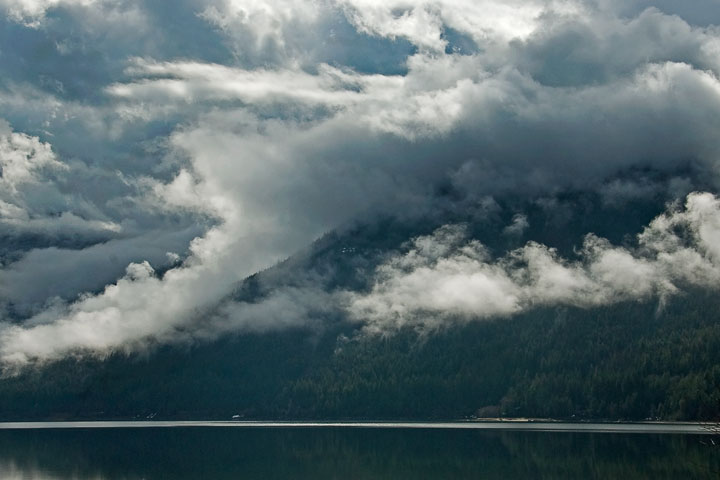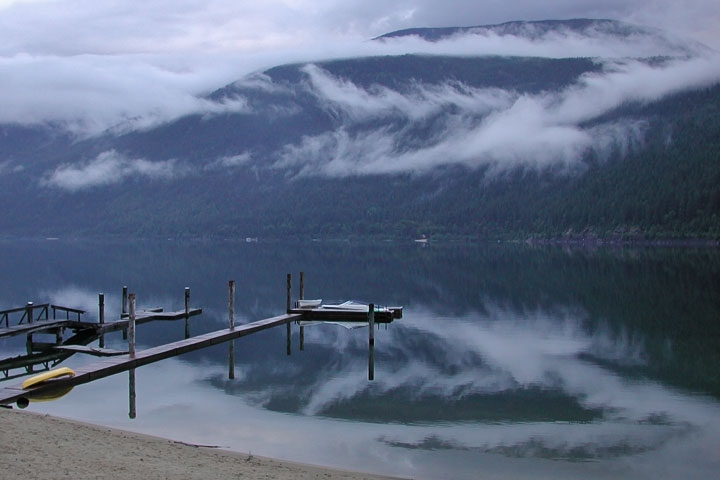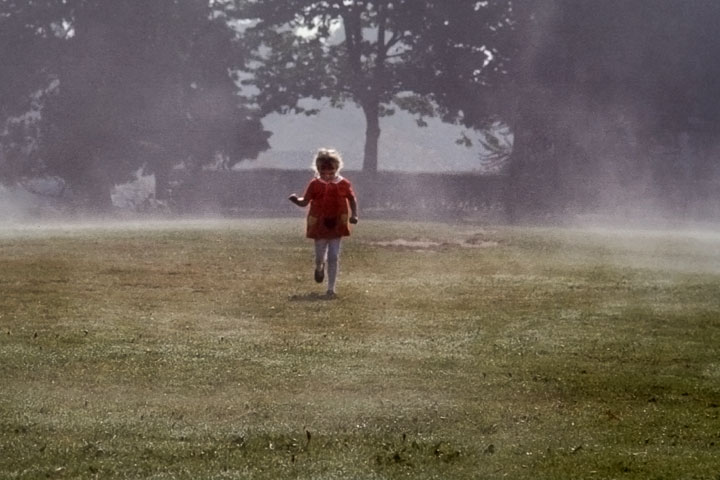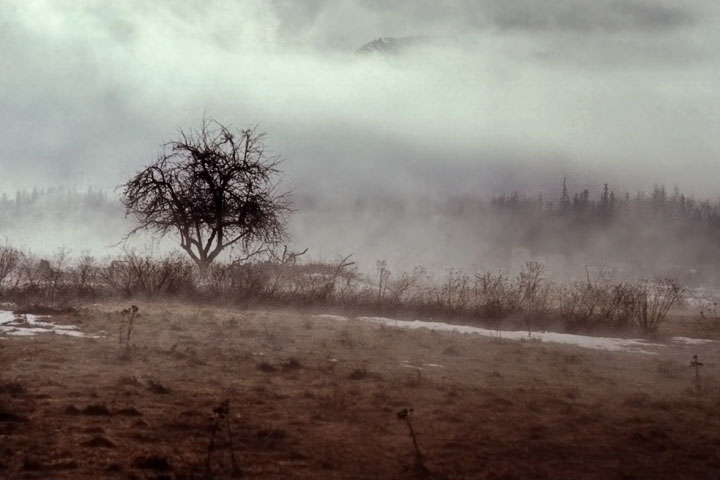Steam fog over land
Droplet condensation in the atmosphere Suspended droplets form by the condensation of water vapour. There are two distinct ways for this to happen: vapour cooling, vapour mixing. For a discussion of these processes, see the page on condensation. The steam fog treated here is produced by vapour mixing.
Steam fog is a frequent visitor to mountainsides, especially after a summer shower. It presents us with some of our most lovely mountain cloudscapes.
Steam fog is produced by the mixing of two parcels of vapour, each of which has a humidity less than 100%, yet the resulting mixture has a humidity greater than 100% and so condensation results. For this to happen, the vapour parcels have to be at markedly different temperatures. But, what are the two sources of the vapour? One is the ambient cool air flowing past the surface. The other is the air immediately adjacent to the surface, which has been warmed and moistened by the surface. The wind mixes these two disparate vapour sources resulting in a humidity of greater than 100% and condensation—steam fog.
The above paragraph leaves unanswered the question of why the land surface was moist and warm, and so why it could effectively warm and moisten the adjacent air. The causes are delightfully varied, leading to different looking clouds. The moisture on the surface may have been supplied by rain, dew, or even snow melt. The relative warmth of the surface may have been present all along and colder air merely flowed by it, or it may have come about because the sun came out and warmed the surface above the temperature of the ambient air. Some possibilities are explored in the pictures below.
Steam fog over the Lake
Even though the underlying process of condensation is the same for steam fog over the land as over the Lake, both the meteorological situation and the appearance is sufficiently different to warrant a separate page to treat steam fog over the Lake.
 Steam fog on the mountainside A spring shower has soaked the mountainside and brought cool moist air to the valley. The trees present a very large warm most surface area to warm and moisten the adjacent air. As the vapour in this air mixes with the ambient vapour, a mixing fog is produced. The resulting fog is also buoyant and so begins to flow up the mountain slope with the result that adiabatic cooling produces even more condensation. The resulting cloudscape is quite lovely.
Steam fog on the mountainside A spring shower has soaked the mountainside and brought cool moist air to the valley. The trees present a very large warm most surface area to warm and moisten the adjacent air. As the vapour in this air mixes with the ambient vapour, a mixing fog is produced. The resulting fog is also buoyant and so begins to flow up the mountain slope with the result that adiabatic cooling produces even more condensation. The resulting cloudscape is quite lovely.
 The moisture for the steam fog rising off this fence came from overnight dew. The morning Sun quickly heats the fence causing evapouration and the warming and moistening of a thin layer of adjacent air. This warm vapour mixes with the cooler vapour in the ambient air and a buoyant steam fog is formed which flows up the fence in a plume. In the left picture, steam fog flows off the sun–facing surface, and as the warmth is conducted through the wood, begins to flow off the shaded side. Finally, in the right picture the sun–facing side has dried and the plume only arises from the back, yet still allowing the robin to get a steam bath.
The moisture for the steam fog rising off this fence came from overnight dew. The morning Sun quickly heats the fence causing evapouration and the warming and moistening of a thin layer of adjacent air. This warm vapour mixes with the cooler vapour in the ambient air and a buoyant steam fog is formed which flows up the fence in a plume. In the left picture, steam fog flows off the sun–facing surface, and as the warmth is conducted through the wood, begins to flow off the shaded side. Finally, in the right picture the sun–facing side has dried and the plume only arises from the back, yet still allowing the robin to get a steam bath.
 A rain moistens the road; the Sun comes out and heats the surface; steam fog arises from the road.
A rain moistens the road; the Sun comes out and heats the surface; steam fog arises from the road.
 The rain moistened trees on the mountainside have produced steam fog, which is also seen reflected in the surface of the Lake.
The rain moistened trees on the mountainside have produced steam fog, which is also seen reflected in the surface of the Lake.
 Dew moistened the grass overnight. With sunrise, the grass is warmed giving rise to steam fog.
Dew moistened the grass overnight. With sunrise, the grass is warmed giving rise to steam fog.
 This ground has been moistened by snowmelt. All that is then needed is for much colder air to flow over it and the relatively warm moist ground produces steam fog.
This ground has been moistened by snowmelt. All that is then needed is for much colder air to flow over it and the relatively warm moist ground produces steam fog.
 The rainbow tells the story: the mountainside is moistened by rain; it is also warmed by the Sun; steam fog is produced.
The rainbow tells the story: the mountainside is moistened by rain; it is also warmed by the Sun; steam fog is produced.
![]()